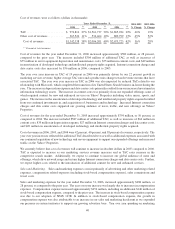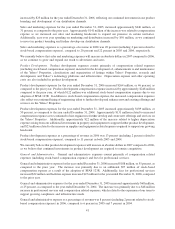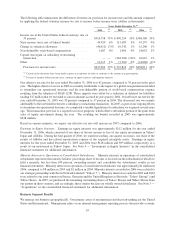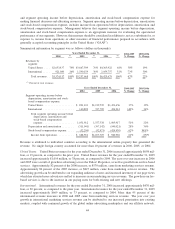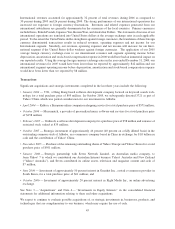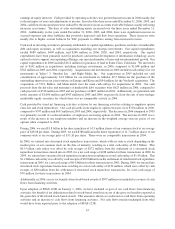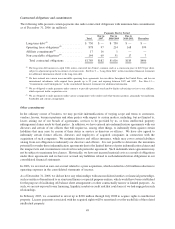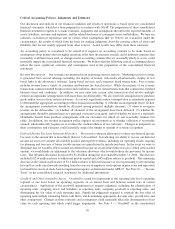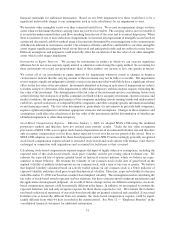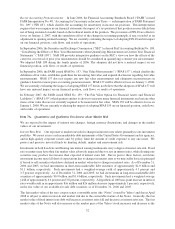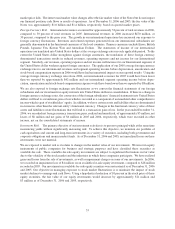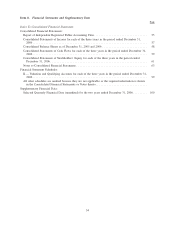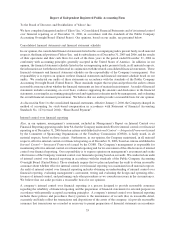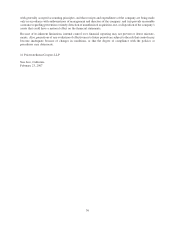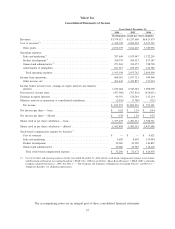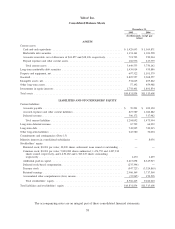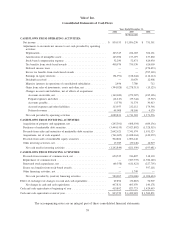Yahoo 2006 Annual Report Download - page 60
Download and view the complete annual report
Please find page 60 of the 2006 Yahoo annual report below. You can navigate through the pages in the report by either clicking on the pages listed below, or by using the keyword search tool below to find specific information within the annual report.Critical Accounting Policies, Judgments and Estimates
Our discussion and analysis of our financial condition and results of operations is based upon our consolidated
financial statements, which have been prepared in accordance with GAAP. The preparation of these consolidated
financial statements requires us to make estimates, judgments and assumptions that affect the reported amounts of
assets, liabilities, revenues and expenses, and the related disclosure of contingent assets and liabilities. We base our
estimates on historical experience and on various other assumptions that we believe are reasonable under the
circumstances, the results of which form the basis for making judgments about the carrying values of assets and
liabilities that are not readily apparent from other sources. Actual results may differ from these estimates.
An accounting policy is considered to be critical if it requires an accounting estimate to be made based on
assumptions about matters that are highly uncertain at the time the estimate is made, and if different estimates that
reasonably could have been used, or changes in the accounting estimate that are reasonably likely to occur, could
materially impact the consolidated financial statements. We believe that the following critical accounting policies
reflect the more significant estimates and assumptions used in the preparation of the consolidated financial
statements.
Revenue Recognition. Our revenues are generated from marketing services and fees. Marketing services revenue
is generated from several offerings including: the display of textual, rich media advertisements, display of text
based links to the advertiser’s websites, listing based services, and commerce based transactions. Fees revenue
includes revenue from a variety of consumer and business fee-based services. While the majority of our revenue
transactions contain standard business terms and conditions, there are certain transactions that contain non-standard
business terms and conditions. In addition, we may enter into certain sales transactions that involve multiple
element arrangements (arrangements with more than one deliverable). We also enter into arrangements to purchase
goods and/or services from certain customers. As a result, significant contract interpretation is sometimes required
to determine the appropriate accounting for these transactions including: (1) whether an arrangement exists; (2) how
the arrangement consideration should be allocated among potential multiple elements; (3) when to recognize
revenue on the deliverables; (4) whether all elements of the arrangement have been delivered; (5) whether the
arrangements should be reported gross as a principal versus net as an agent; and (6) whether we receive a separately
identifiable benefit from purchase arrangements with our customers for which we can reasonably estimate fair
value. In addition, our revenue recognition policy requires an assessment as to whether collection is reasonably
assured, which inherently requires us to evaluate the creditworthiness of our customers. Changes in judgments on
these assumptions and estimates could materially impact the timing or amount of revenue recognition.
Deferred Income Tax Asset Valuation Allowance. We record a valuation allowance to reduce our deferred income
tax assets to the amount that is more likely than not to be realized. In evaluating our ability to recover our deferred
income tax assets we consider all available positive and negative evidence, including our operating results, ongoing
tax planning and forecasts of future taxable income on a jurisdiction by jurisdiction basis. In the event we were to
determine that we would be able to realize our deferred income tax assets in the future in excess of their net recorded
amount, we would make an adjustment to the valuation allowance which would reduce the provision for income
taxes. The valuation allowance decreased by $1.4 billion during the year ended December 31, 2006. The decrease
included a $236 million release to additional paid-in capital and a $95 million release to goodwill. The remaining
decrease in the valuation allowance of $1.1 billion relates to deferred income tax assets pertaining to net operating
loss and tax credit carryforwards resulting from the exercise of employee stock options in prior years and represents
tax benefits in excess of stock-based compensation expense as determined under APB 25. See Note 10 — “Income
Taxes” in the consolidated financial statements for additional information.
Goodwill and Other Intangible Assets. Goodwill is tested for impairment at the reporting unit level (operating
segment or one level below an operating segment) on an annual basis and between annual tests in certain
circumstances. Application of the goodwill impairment test requires judgment, including the identification of
reporting units, assigning assets and liabilities to reporting units, assigning goodwill to reporting units, and
determining the fair value of each reporting unit. Significant judgments required to estimate the fair value of
reporting units include estimating future cash flows, and determining appropriate discount rates, growth rates and
other assumptions. Changes in these estimates and assumptions could materially affect the determination of fair
value for each reporting unit which could trigger impairment. See Note 5 — “Goodwill” in the consolidated
50


